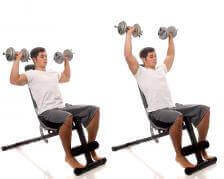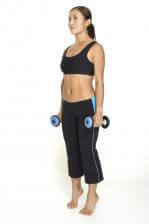The Best Exercises for 7 Popular Trouble Spots (Part 1)
Find out the best butt, hip and thigh exercises, the best calf exercises, the best chest exercises, the best shoulder exercises, the best back exercises, the best arm exercises and the best ab exercises in this two-part series. Up first are the legs, calves, and chest. Keep reading to find out how to best target these trouble spots.

Sponsor: This episode is brought to you by DailyBurn, the best fitness anywhere. Access online workout videos featuring a variety of programs, from tabata to interval training to yoga. Get the first 30 days free when you go to dailyburn getfitguy.
Have you ever wished you could just walk into a gym and get a customized list of the very best exercises to target your specific trouble spots? Consider this 2-part episode series your go-to guide for the best butt, hip and thigh exercises, the best calf exercises, the best chest exercises, the best shoulder exercises, the best back exercises, the best arm exercises, and the best ab exercises. In Part 1, you’ll learn about the legs, calves and chest.
How to Find Out How Much A Muscle Contracts
Sports and exercise scientists utilize many different tools and methods to help them determine how much a muscle contracts during a specific movement, how many calories a specific movement burns, or how much stress is placed on a joint during a movement. One of the most popular and effective tools used to measure muscle utilization is electromyography, also known as “EMG.”
EMG simply measures the electrical activity produced by muscles, and is performed using a special instrument called an electromyograph. The electromyograph creates a record called an electromyogram, which scientists then use to quantify the strength or quality of a muscle contraction. EMG signals can also be used to analyze medical abnormalities, the activation level of different areas of a muscle, the order in which muscles are recruited, and biomechanical abnormalities from injuries or poor movement patterns.
The Best Exercises for 7 Popular Trouble Spots
So what can EMG tell us about the best exercises for 7 popular trouble spots? Many studies have used EMG to study the extent to which certain exercises activate certain body parts. So if we know which exercises cause maximum activation of a specific body part, we can use those exercises to create the best workout plan for that specific body part (or trouble spot)!
Below, you will find a list of trouble spots and the best exercises for each.
Butt, Hip, and Thighs
In a recent Get-Fit Guy newsletter, I revealed that 2 different exercises cause your glutes to grunt the hardest:
- Prone bent leg hip extension against manual resistance. Yep, that’s a mouthful. Basically, the move involves getting into a crawl position with hands and feet on the ground and then kicking out behind you with one leg – against a partner who is manually resisting your kicking force. Of course, you could also do this exercise against resistance such an elastic band, as I describe in the article “How to Tone Your Butt,” but it’s not quite as effective as having a partner resist your kicking force.
- Standing butt squeezes with a wide stance and feet turned out. This one is a bit hard to describe, but I’m going to give you the description from one of my favorite butt-experts – Bret Contreras, who says:
“From a standing position, take a moderate to wide stance and flare the feet out slightly. Now squeeze the glutes as hard as possible for 30 seconds. Make “fists” to increase the neural drive through irradiation. Just do this one time.”
Want even more butt tips? Then check out the episode “How to Get A Better Butt.”
In addition to your butt, it’s important to target your hips and thighs. It turns out the very best 2 exercises for activating your hips and thighs are the deadlift, in which you simply lift a heavy weight from the ground, and the glute ham raise, which is a special apparatus at the gym that is also know as the low back extension.
For the deadlift (which I also list as one of my 2 favorite exercises for getting a flat stomach), the basics are simple. You just pick a weight such as a barbell, dumbbell, kettlebell or any other heavy object off the ground while using good form that relies on your hips and legs, and not your lower back.
For the glute ham raise or low back extension, begin by adjusting the equipment to fit your body. With your feet against the footplate in between the rollers as you lie facedown, your knees should be just behind the pad. Keep your back arched as you begin the movement by flexing the knees and driving your toes into the foot plate as you do so. Keep your upper body straight, and continue until your body is upright, then return to the starting position, keeping your descent under control.
Calves

For even more activation, you can stretch your calves prior to going up onto your tip toes. To do this, stand on the edge of a stair, box or other platform and dip your heels as low as possible before contracting your calf muscles and rising up onto your toes. Go back slowly to the starting position as you breathe in by lowering your heels as you bend the ankles until calves are stretched.
You can also make this exercise more difficult by adding weight, which is often done by using a weighted standing calf raise machine at a gym.
Chest
The best exercises for your chest (affectionately called by fitness geeks “the pecs”) are the dumbbell bench press and weighted dips.

For weighted dips, place a bench or chair behind your back and another bench or chair in front of you. With the benches (or chairs) perpendicular to your body, hold on to one bench on its edge with your arms fully extended, your hands close to your body and separated at shoulder width.
Meanwhile, your legs should be extended forward on top of the other bench. Your legs should be parallel to the floor while your torso is perpendicular to the floor. Then put a dumbbell or any other weight on your lap (this works best if you have a partner put the weight in your lap) and slowly lower your body by bending at the elbows until you lower yourself far enough to where there is an angle that is slightly less than 90 degrees between the upper arm and the forearm. Then simply push yourself back to the starting position while exhaling.
In part 2, I’ll tell you the best exercises for your shoulders, back, arms, and abs, but in the meantime, if you have more questions about the best exercises for your body’s trouble sports, leave them over at Facebook GetFitGuy.
Images courtesy of Shutterstock
You May Also Like…







